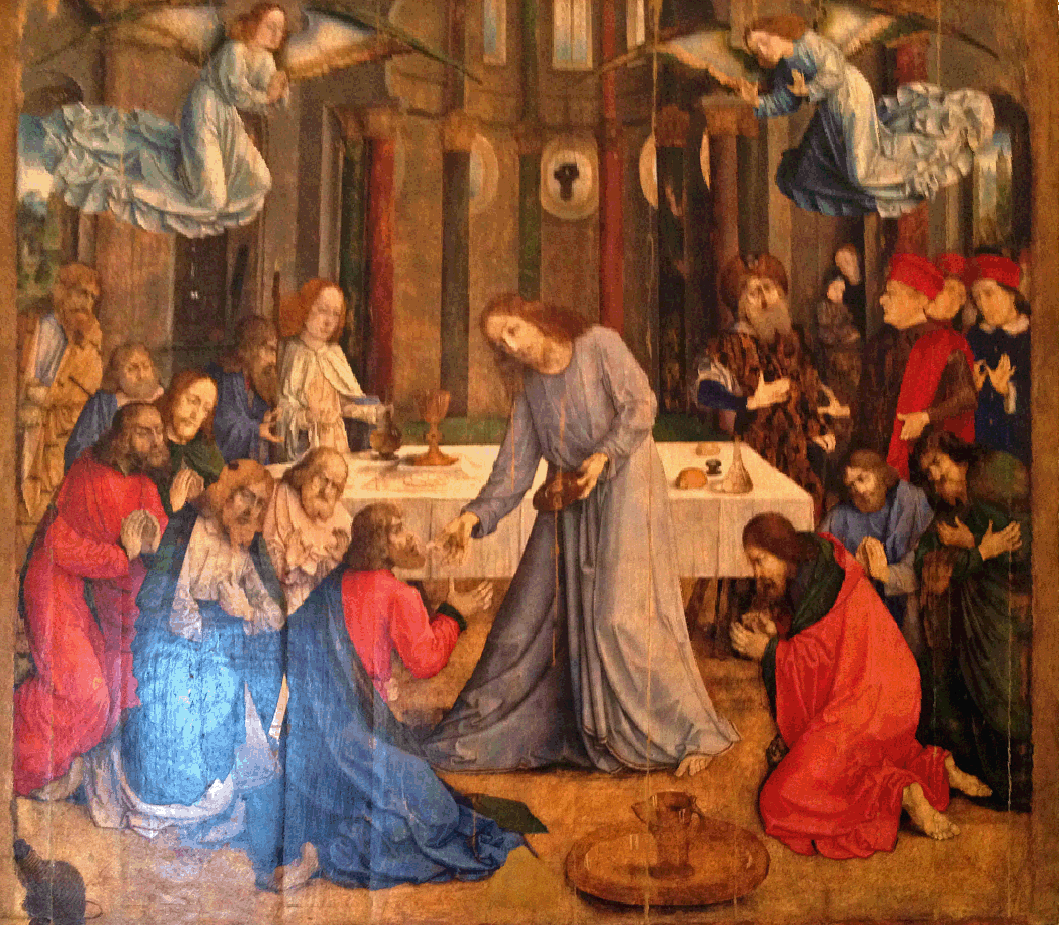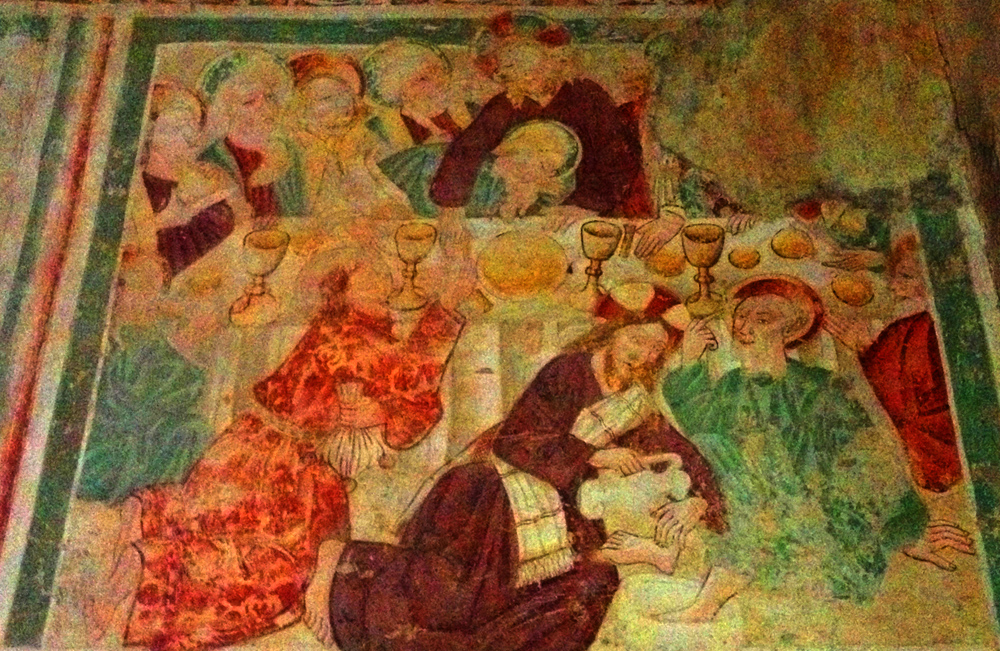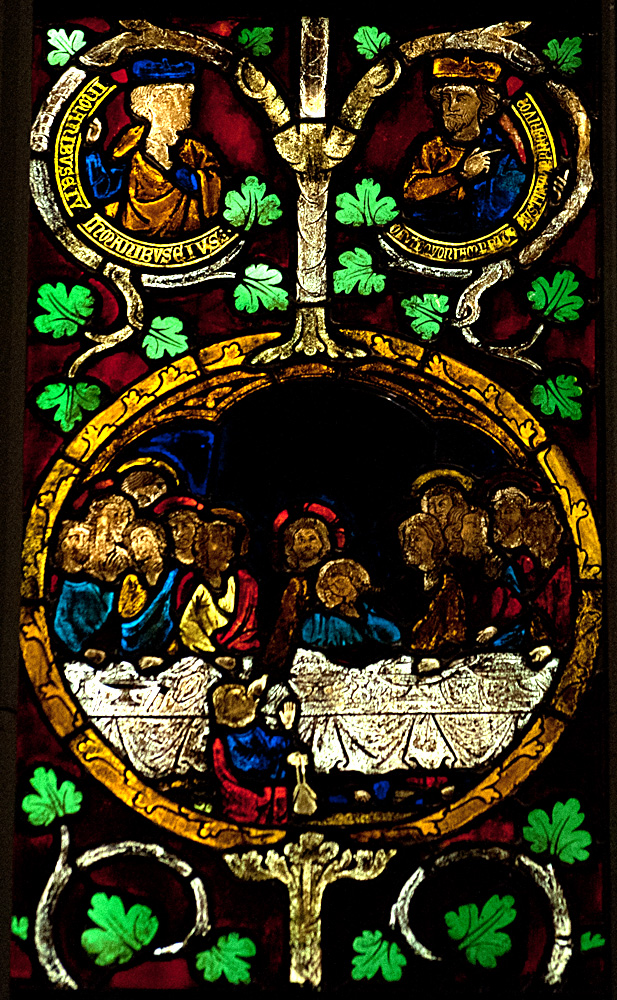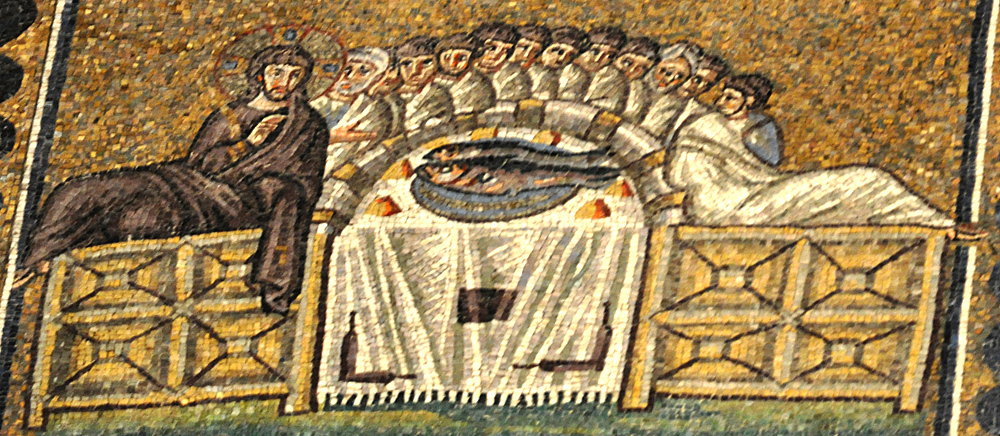The Iconography
THE LAST SUPPER AND THE EUCHARIST
The synoptic gospels trace the institution of the Eucharist to the Last Supper, and the commentaries make much of this connection.3 As early as the mid-6th century, two miniatures in a Greek Gospel book picture the Apostles queued up as if in a communion line to receive the host from Jesus' hands. Later in the century this manuscript illustration with the title "Supper of the Lord" has Jesus dressed like a priest blessing a communion host. Then, starting in about the 9th century, Byzantine altars will feature an icon called The Communion of the Apostles in which Christ is dressed as a priest and distributes the host and the chalice to the Twelve (Zographos, 496). Later, Western art followed suit with images of Jesus distributing communion just as in a medieval Mass. The apostles kneel as he puts a host on each tongue, as in the first picture at right.In counterpoint to these solemn renditions of the institution of the Eucharist, the 16th century brings more dramatic and down-to-earth images of the supper. In Bassano's 1546 version the Apostles in contemporary fisherman's clothes argue forcibly with each other while on the floor a cat slinks in toward a sleeping dog. Subsequently Tintoretto expounds on the meaning of the Eucharist as Charity, as in this 1570 canvas, where one Apostle shares his bread with a beggar while another hands a fruit to a little boy in rags.
JUDAS
John 13:1-5 implies that Jesus included Judas among the communicants, and most commentators agree with St. Leo that he did so "that it might be made manifest that Judas was provoked by no wrong."4 Accordingly, the images normally include Judas at the Communion. He is also present in most images of the supper itself. Some have him dipping his hand in a dish, as in Matthew and Mark (example), or touching the table at the same time as Jesus, as in Luke (example). Others will show him with a money bag (as in the first picture at right), referring either to his role as treasurer (John 13:29) or to the thirty pieces of silver that the authorities had given him (Matthew 26:14-15).SEATING ARRANGEMENTS
In ancient Greece and Rome participants in a banquet would lie on couches arranged around a table. This is what the synoptic gospels mean when they say Jesus and the Apostles "reclined" at the Last Supper.5 Accordingly, the earliest images of the supper picture the figures lying on couches around a semi-circular table. The table's shape allows them to be pictured face-forward. Usually Jesus is on the left, as in the image above and this miniature from about 550. In later centuries when people sat at tables the Last Supper images changed accordingly. The earliest known example with seated Apostles is this panel from a 6th-century manuscript illustration. This mosaic from the 12th or 13th century still has the semicircular table but puts the Apostles on chairs. A rectangular table is first seen in a 10th-century evangelary in the treasury of Prague Cathedral.6 By the later 13th century it has become traditional to arrange the figures on the far side of a long rectangular table facing the viewer, with Jesus at the center (example). This of course is the pattern that was adopted in the famous Da Vinci version.THE PRETTY MAN
In the da Vinci painting the person on Christ's right hand is most certainly the apostle John. He looks rather girlish to modern eyes, and a recent scandalous book claims that the figure is really Mary Magdalene. But an understanding of the iconography of St. John provides three excellent reasons for rejecting such a claim.First, a medieval and Renaissance way of representing a man as young is to show him as beardless and girlish (as in portraits of St. Sebastian).
Second, it is clear that medievals recognized the young person in the Last Supper images as St. John, the discipulus (masculine) who the gospel says "leaned on his [Jesus'] breast at supper" (John 21:20). For example, this illustration from a manuscript of the Third Letter of John pictures the author as the young person leaning on Jesus's breast at the Last Supper. And in virtally all Last Suppers, there would not be a total of twelve Apostles if the person in question were not John.
Finally, we sometimes find a girlish John in Last Supper images that also include Mary Magdalene herself. In a 16th-century Last Supper tapestry, for example, a very girlish John rests his head on Christ's chest while the latter drapes his arm around the youth's shoulder. Mary Magdalene sits directly across the table from them, her left hand reaching for the jar of oil that she will use for Christ's feet. In this image, she embraces his feet beneath the table while the beardless John reclines his head on his chest.
Clearly then, the pretty young person at Christ's side in the da Vinci painting is not a coded revelation about the Magdalene but simply a recursion to the conventional iconography of St. John.
THE WASHING OF THE FEET
Secondary topics treated in other Last Supper images include Christ's washing of the apostles' feet (John 13:1-11). John's gospel records that Peter at first demurred from having the Lord wash his feet, but when Jesus insisted Peter asked that he also wash his head and hands. In some 13th-century images Peter puts his hand to his head in reference to the follow-up request (example). Some of Tintoretto's numerous images of the foot-washing present the initial refusal instead (example); one of them collapses the two moments into a single animated colloquy between Peter and Christ.
Prepared in 2016 by Richard Stracke, Emeritus Professor of English, Augusta University.
HOME PAGE
Sixth-century mosaic in Sant'Apollinare Nuovo, Ravenna. See the description page for details.
OTHER IMAGES

In this 15th-century painting an apostle kneels to receive a communion host from Jesus. Standing at the far left, Judas holds the money bag. At the far right, the chief priest appears to be arguing with a delegation led by the donor, Federico da Montefeltro! – See the description page.

This Last Supper from Croatia combines the washing of the feet with the identification of Judas as the betrayer. – See the description page.

In a stained glass window from the 13th century, Jesus and Judas dip hands into a dish. With his other hand Judas holds the purse. – See the description page.
MORE IMAGES
- 5th century: A very early example of fish (but not yet the boy) at the Last Supper in this panel in an ivory diptych from Ravenna.
- 11th century: The left side of the "Latin Diptych" in the museum of Milan's cathedral begins its sequence of Passion images with the washing of the feet.
- 13th century: In this fresco in Croatia Jesus and Judas dip their hands in the dish. This is one of the early examples of setting the Apostles at a long table.
- Late 13th century: Altarpiece of the Madonna and Child including a panel for the Last Supper with a semi-circular table.
- 13th/14th century: A fresco in Austria
- 14th century: Unusually for this period, this fresco in Pomposa Abbey puts the Apostles at a fully round table but still manages to make all the faces visible.
- 1344: Detail of the washing of the feet in Guariento di Arpo's Coronation of the Virgin altarpiece.
- 15th century: Fra Angelico pictures the Apostles receiving communion hosts at an L-shaped table, with a praying woman at one end who may be the Virgin Mary.
- 16th century: Painting in San Moisè, Venice
- 16th century, last quarter: The Last Supper is one of four paintings of types of the Eucharist in identical frames in a Venice church.
- 1570: Painting by Tintoretto in Santo Stefano, Venice
- 1592-94: Painting by Tintoretto in San Giorgio Maggiore, Venice
- 1637: Fresco by Giacomo Grassi and Agostino Litterini
- 1753-62: Meana, Jesus Washes Peter's Feet
- 19th century (?) Painting in St. Anthony, Dubrovnik
- Late 19th century: Lucas Valdés's painting adds the Father and the Holy Spirit to the traditional scene.
- 1895: Neo-medieval High relief by J. Rotermund
- 20th century: Stained glass window of the Communion of the Apostles
NOTES
1 The "Last Supper" is the Passover feast that Jesus celebrated with the Apostles on the night before he was crucified, at which he was believed to have instituted the Eucharist. See Matthew 14:15-21, Mark 6:34-44, Luke 9:12-17, and John 6:1-13.
2 Jensen discusses the fish symbol and other implications of this image type in Understanding Christian Art, 52-59.
3 See, for example, the comments on Matthew 26:26-29 in the Catena Aurea, I, iii, 890-98.
4 "And after the morsel, Satan entered into him," John 13:27. For the phrase from Leo and concurring comments, see the Catena Aurea, I, iii, 893-94.
5 Matthew 26:20, Mark 14:18, and Luke 22:14. All use forms of the verb discumbere, to recline.
6 Kirschbaum, I, 15.
